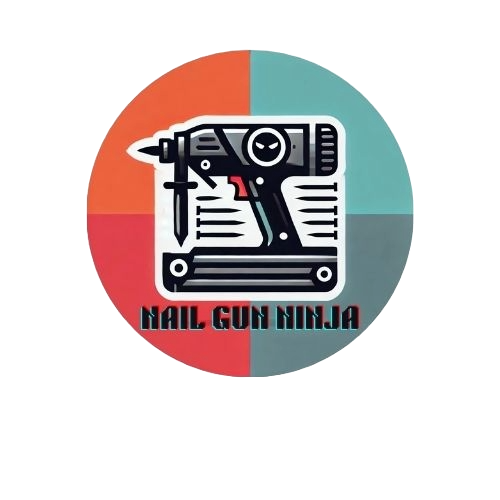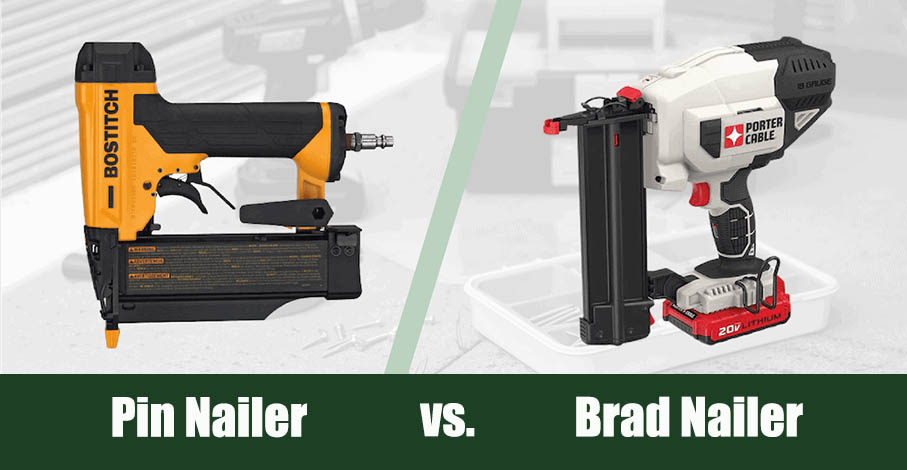When it comes to choosing the right tool for your DIY project, it can be confusing trying to decide between a pin nailer vs a brad nailer. Both have their unique benefits and drawbacks, so how do you know which one is right for you?
A pin nailer and a brad nailer are widely used in the woodworking and carpentry industry. Their main purpose is to join two pieces of wood together, but they do have some subtle differences.
Both tools use small nails (either pins or brads) and woodworkers and carpenters use them for different purposes!
Pin nailers are typically used for more delicate projects, such as working with molding or joining small pieces of wood together. Brad nailers are better suited for heavier-duty projects, such as building furniture or cabinets.
What is a Pin Nailer?
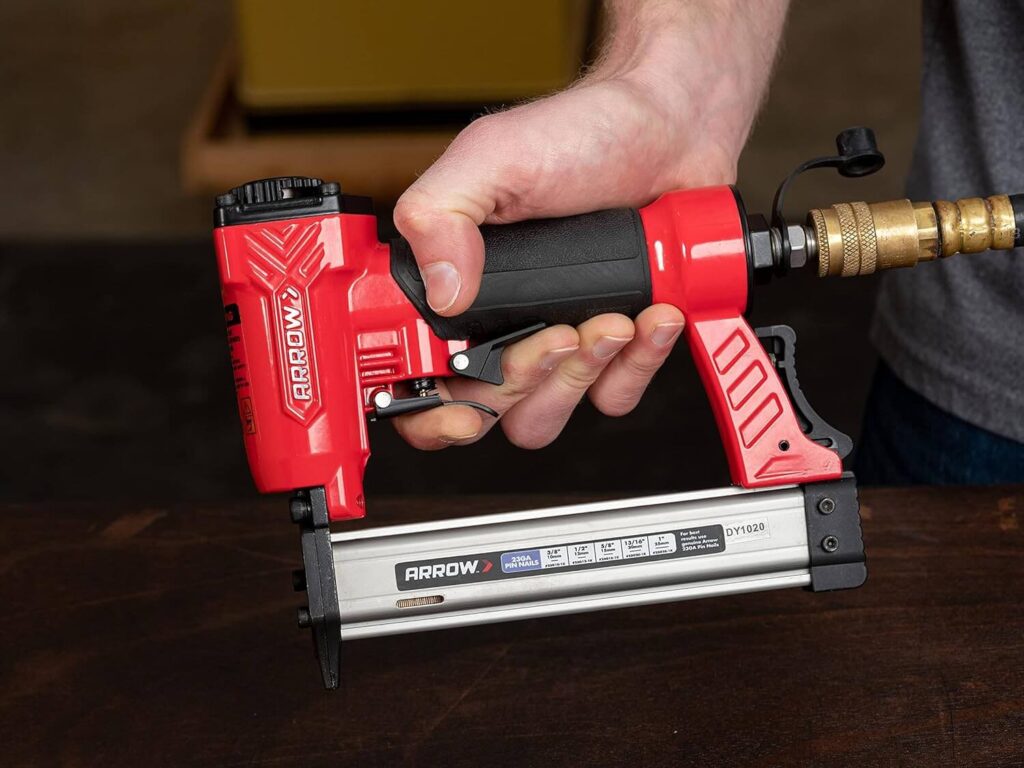
A pin nailer is a small nail gun that shoots very thin 23 gauge nails, perfect for light woodworking. These nails have tiny heads that are almost invisible, making the finish look clean and smooth.
Pin nailers are great for thin or delicate materials where regular nails might cause cracks or splits.
Most pin nailers use an air compressor for power, but some battery-powered models are available. They are best for small, detailed work but not strong enough for heavy-duty projects.
The thin nails can’t hold a lot of weight or pressure. If you need more strength, a brad nailer is a better choice. Pin nailers are ideal for projects that need a neat finish without damaging the wood.
Pros and Cons of a Pin Nailer
Pros
- The small 23 gauge nails leave tiny holes.
- Less cracks or splits in delicate materials.
- Makes the woodwork look smooth and professional.
- Great for securing thin or fragile pieces without breaking them.
- Smaller and more comfortable to handle.
Cons
- Not ideal for heavy duty projects.
- Requires wood glue or adhesives for better strength.
- Comw with less holding power.
- Unbale for framing or structural works.
What is a Pin Nailer Used For?
Pin nailers mostly use 23 gauge nails, which are tiny and have very thin shafts. The small diameter of the nails makes them ideal for delicate projects where you don’t want the nails to split the wood or leave big holes.
In addition, the nails are too small to notice so they are ideal for projects where you want the wood to look natural without any visible fasteners.
Small projects like DIY projects, holding photo frames together, assembling small pieces of wood, attaching decorative molding, etc mostly require a pin nailer.
You can not take it as a versatile tool as it is not suitable for heavy-duty projects. If you want to go for a true versatile nail gun then a 16 gauge nailer is a great option for many different projects.
What is a Brad Nailer?
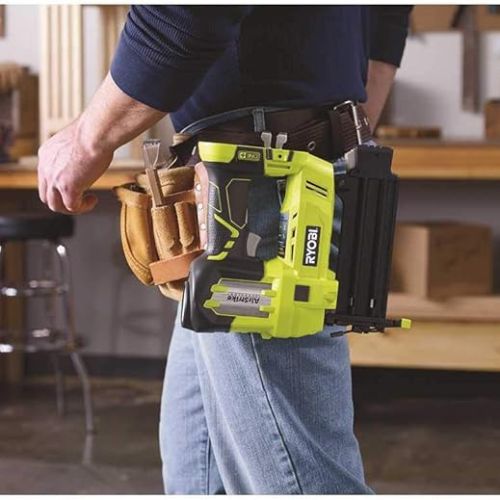
A brad nailer is a useful tool for many woodworking projects, from small tasks to larger jobs. It works well on both soft and hard woods. Brad nail guns are great choice for different materials and projects.
Brad nailers usually use 18 gauge nails, and the size of the nail depends on the thickness of the wood you’re working with.
Brad nailers come with features that make your work easier. Some models have bump fire triggers, letting you shoot nails quickly, while others have sequential fire triggers, which require you to pull the trigger for each nail.
Many also have adjustable depth settings so you can control how deep the nails go. Some models even have air blowers that clear away sawdust before firing, which helps when working in small spaces.
However, brad nailers leave slightly larger holes, and the nails don’t hold as strongly as screws.
Pros and Cons of a Brad Nailer
Pros
- Uses 18 gauge nails that provide stronger hold than a pin nailer.
- Great for delicate and medium projects.
- Unlike pin nails, brad nails have enough holding power.
- They don’t need extra glue to ensure better holding strength.
- Available in cordless models.
Cons
- Can not handle thick wood, framing, or load bearing structures.
- They come with holding power but it is limited. They are weaker than finish or framing nails.
- Although small headed nails. However, the heads may still require filling for a seamless finish.
What is a Brad Nailer Used For?
Brad nailers are great for many tasks because they hold better than pin nailers. They are perfect for home improvement jobs that need a strong, reliable hold.
Paneling
Brad nailers make it easy to attach wood panels to walls. The nails hold well, and any small holes left can be filled with wood filler before painting or staining.
Trim Work
Brad nailers are perfect for adding trim to walls, doors, and windows. They help you quickly and easily attach trim pieces, whether simple or fancy.
Molding
Adding molding to a room is easy with a brad nailer. It helps you attach molding securely without needing screws or big nails, giving your room a neat, finished look.
Key Differences – Pin Nailer vs Brad Nailer
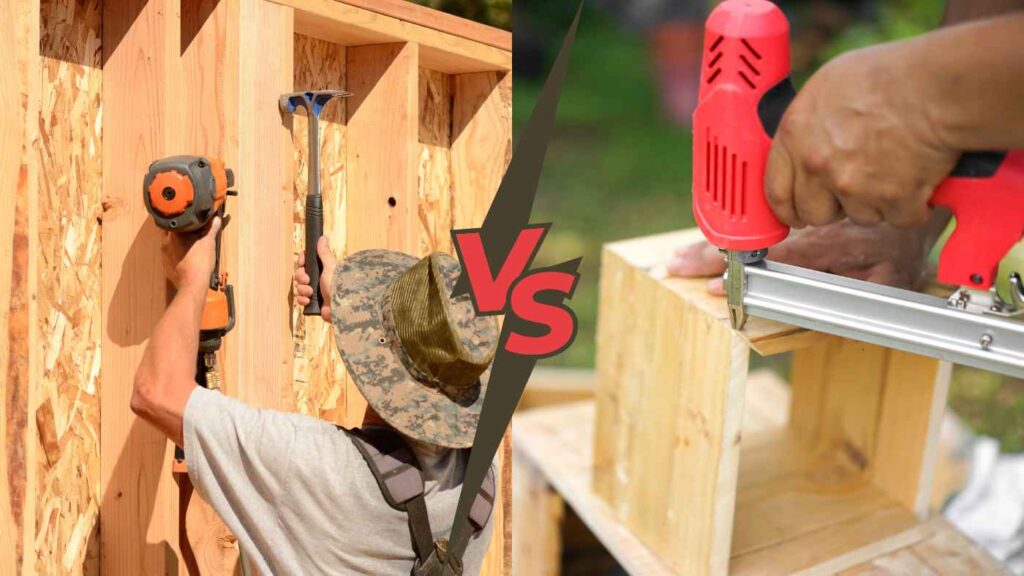
Size
Pin nailers are smaller than brad nailers. This makes them more versatile and easier to maneuver, especially in tight spaces.
Brad nailers on the other hand are larger and heavier, making them better suited for bigger projects.
Power
Pin nailers use less power than brad nailers. This makes them ideal for lighter-duty tasks.
Brad nailers on the other hand pack more power, making them better suited for tougher projects such as nailing into hardwoods.
Nail Length Options
Pin nailers use short nails, usually from 1/2 inch to 1 inch long.
Brad nailers use longer nails, ranging from 1 inch to 2 inches which makes them better for thicker materials.
Applications
For crafting, upholstery, and cabinetmaking, you can use a pin nailer.
Brad nailers on the other hand suit better for larger projects such as trim work, baseboards, and molding.
Holding power
Brad nailers have a stronger holding power than pin nailers. If you’re looking for a tool that can handle tougher projects, a Brad nailer is the way to go.
Pin nailers, on the other hand, suit better for lighter-duty tasks. This also makes Brad nailers a better choice for projects that require permanent fastening.
Cost
Pin nailers are typically more affordable than brad nailers. This makes them a great choice for budget friendly DIYers and hobbyists.
Brad nailers on the other hand are more expensive, but they’re also more versatile and powerful. You should know how much is a nail gun before buying them.
Precision
Pin nailers are perfect for projects that need very small, precise nails, leaving little to no mark on your work.
Brad nailers are accurate but may leave slightly bigger holes because of the size of the nails.
Ease of Use
Pin nailers are light and easy to control, making them ideal for small, detailed work.
Brad nailers are still easy to use but may take a little more strength, especially on larger tasks.
Flexibility in Material Use
Pin nailers are best for softwood or delicate materials because they don’t leave much of a mark.
Brad nailers work on both soft and hard wood, giving you more options for different types of projects.
Finish Quality
Pin nailers leave a clean finish with no visible marks.
Brad nailers may leave small holes, but they still offer a cleaner finish than bigger framing nails.
Durability
Brad nailers are made to last longer because they’re used for tougher jobs.
Pin nailers are best for light tasks, so they may not last as long as brad nailers.
Noise Level
Pin nailers are quieter since they don’t use as much power.
Brad nailers are louder because they have more power behind them.
Pin vs Brad Nailer – At a Glance
| Feature | Pin Nailer | Brad Nailer |
| Size | Smaller and more compact | Larger and heavier |
| Power | Uses less power, ideal for light-duty tasks | More powerful, better for tougher projects |
| Nail Length Options | 1/2 inch to 1 inch | 1 inch to 2 inches |
| Applications | Crafting, upholstery, cabinetmaking | Trim work, baseboards, molding |
| Holding Power | Weaker but only better for light duty tasks | Stronger and better for tougher projects |
| Cost | More affordable | More expensive |
| Precision | High precision | Accurate but may leave slightly bigger |
| Ease of Use | Light and easy to control for small projects | Easy to use but require more strength |
| Flexibility in Material Use | Best for softwood and delicate materials | Works on both soft and hard woods |
| Finish Quality | Clean and professional | Small holes but cleaner than larger |
| Durability | Shorter lifespan for light tasks | More durable for tougher jobs |
| Noise Level | Quieter due to lower power | Louder due to higher power |
Which one is Better – Pin vs Brad Nailer
Both tools are great for specific applications. It depends on:
- What project you’re working on
- The materials you’re working with
- Your personal preferences
Delicate and precise work requires using a pin nailer. They’re perfect for finish and trim work or any time you need to avoid marring the surface of your project. However, they have less holding power and it can be hard to remove the pins because they’re so small.
Brad nailers are a bit more powerful and versatile. They’re perfect for when you need to put together heavier pieces of wood or when you need a stronger bond. However, they can be more difficult to control and there is a risk of splitting the wood if you’re not careful.
Both tools have their pros and cons, so it comes down to what you need them for. If you’re not sure, it’s always best to consult with a professional before making your purchase.
My Final Verdict: Brad Nailer vs Pin Nailer
Choosing between a pin nailer and a brad nailer depends on what kind of work you’re doing and what you need from your tool.
Pin Nailer
If you’re working on small detailed projects like crafts, upholstery, or cabinetmaking, a pin nailer is the better choice.
It is precise and leaves barely any mark that makes it great for delicate work on soft wood or other gentle materials. It is best for lighter tasks, easy to use, and comes at a more affordable price.
Brad Nailer
If you are doing bigger jobs like installing trim, baseboards, or molding, a brad nailer is the way to go. It has more power, uses longer nails, and works well on both soft and hard wood.
It is stronger and better for holding things together in tough projects. While it may leave a slightly bigger hole, it is better for permanent, solid work.
While it costs more, it is built to last and handles more demanding tasks.
Conclusion
Choosing between a pin nailer and a brad nailer depends on the type of project you’re working on.
If you’re doing small, detailed tasks that need precision and a clean finish, the pin nailer is the best tool. It’s light, easy to use, and great for delicate materials.
In contrast, if your project involves bigger jobs like putting up trim, baseboards, or other tasks that need more power and strength, the brad nailer is the better choice.
It’s more versatile, works well on tougher materials, and is built to last.
Both tools have their benefits, so the right one depends on the job. Think about the size of your project, the material you’re working with, and how much detail you need, and you’ll know which one to choose.
Your choice should depend on the size and type of project you’re working on!
FAQs
What is the main difference between a pin nailer and a brad nailer?
Ans: The main difference is size and power. A pin nailer is smaller and uses thinner nails for delicate work, while a brad nailer is larger and more powerful, suitable for heavier tasks like trim or baseboards.
Which nailer is quieter, a pin or a brad nailer?
Ans: A pin nailer is quieter because it uses less power. Brad nailers, being more powerful, tend to be louder.
Which tool lasts longer, a pin nailer or a brad nailer?
Ans: A brad nailer tends to last longer because it’s built for tougher jobs. Pin nailers are designed for lighter tasks, so they may not hold up as long under heavy use.
